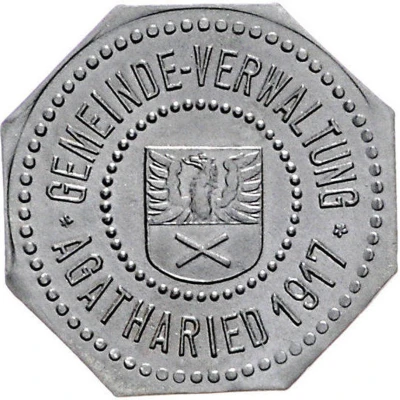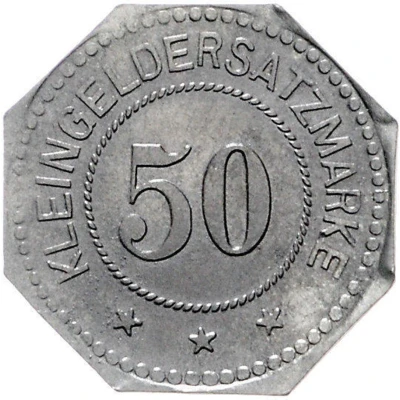


© Münzenhandlung Harald Möller GmbH
50 Pfennigs - Agatharied
1917 year| Zinc | - | 24.4 mm |
| Issuer | Municipality of Agatharied (Federal state of Bavaria) |
|---|---|
| Emperor | William II (Wilhelm II) (1888-1918) |
| Type | Standard circulation coin |
| Year | 1917 |
| Value | 50 Pfennigs (50 Pfennige) (0.50) |
| Currency | Mark (1914-1924) |
| Composition | Zinc |
| Diameter | 24.4 mm |
| Shape | Octagonal (8-sided) |
| Technique | Milled |
| Orientation | Medal alignment ↑↑ |
| Demonetized | Yes |
| Updated | 2024-10-04 |
| Numista | N#296921 |
|---|---|
| Rarity index | 97% |
Reverse
Pearl rim, legend circling pearl circle with denomination centered
Script: Latin
Lettering:
KLEINGELDERSATZMARKE
50
★ ★ ★
Edge
Plain
Interesting fact
One interesting fact about the 50 Pfennigs - Agatharied 1917 coin is that it was minted during a time of economic and political turmoil in Germany. The country was facing hyperinflation, and the value of the German mark had decreased significantly. In response, the government introduced a new currency, the Rentenmark, which was pegged to gold and was intended to stabilize the economy. The 50 Pfennigs - Agatharied 1917 coin was minted in zinc, which was a cheaper alternative to traditional metals like silver or gold, and was used to alleviate the shortage of coins in circulation. Despite its humble origins, the coin remains a fascinating piece of history and a testament to the resilience of the German people during a time of great uncertainty.